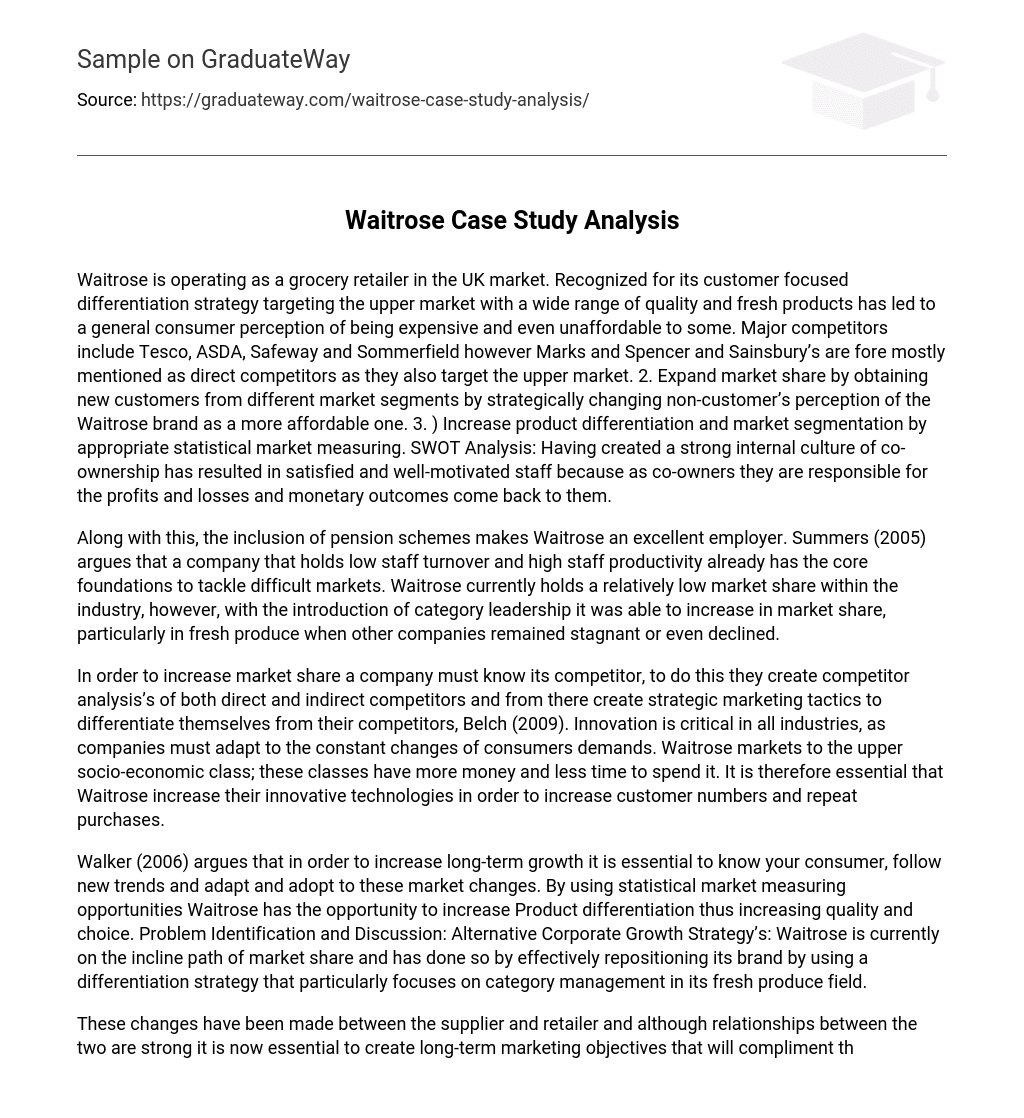Waitrose is operating as a grocery retailer in the UK market. Recognized for its customer focused differentiation strategy targeting the upper market with a wide range of quality and fresh products has led to a general consumer perception of being expensive and even unaffordable to some. Major competitors include Tesco, ASDA, Safeway and Sommerfield however Marks and Spencer and Sainsbury’s are fore mostly mentioned as direct competitors as they also target the upper market. 2. Expand market share by obtaining new customers from different market segments by strategically changing non-customer’s perception of the Waitrose brand as a more affordable one. 3. ) Increase product differentiation and market segmentation by appropriate statistical market measuring. SWOT Analysis: Having created a strong internal culture of co-ownership has resulted in satisfied and well-motivated staff because as co-owners they are responsible for the profits and losses and monetary outcomes come back to them.
Along with this, the inclusion of pension schemes makes Waitrose an excellent employer. Summers (2005) argues that a company that holds low staff turnover and high staff productivity already has the core foundations to tackle difficult markets. Waitrose currently holds a relatively low market share within the industry, however, with the introduction of category leadership it was able to increase in market share, particularly in fresh produce when other companies remained stagnant or even declined.
In order to increase market share a company must know its competitor, to do this they create competitor analysis’s of both direct and indirect competitors and from there create strategic marketing tactics to differentiate themselves from their competitors, Belch (2009). Innovation is critical in all industries, as companies must adapt to the constant changes of consumers demands. Waitrose markets to the upper socio-economic class; these classes have more money and less time to spend it. It is therefore essential that Waitrose increase their innovative technologies in order to increase customer numbers and repeat purchases.
Walker (2006) argues that in order to increase long-term growth it is essential to know your consumer, follow new trends and adapt and adopt to these market changes. By using statistical market measuring opportunities Waitrose has the opportunity to increase Product differentiation thus increasing quality and choice. Problem Identification and Discussion: Alternative Corporate Growth Strategy’s: Waitrose is currently on the incline path of market share and has done so by effectively repositioning its brand by using a differentiation strategy that particularly focuses on category management in its fresh produce field.
These changes have been made between the supplier and retailer and although relationships between the two are strong it is now essential to create long-term marketing objectives that will compliment these relationships in order to increase market share throughout the entire company. By doing so Waitrose must adopt the following strategic objectives in order to continue the successful incline of market share: Innovation is critical in companies who sell to upper socio-economic markets, as these markets tend to hold a higher income than other markets giving them the resources to purchase new technologies and adopt them early on.
Kotler (2001) suggests that repeat purchase and brand loyalty are essential elements in increasing market share, it is therefore it is essential for Waitrose to keep up-to-date with their consumers. Waitrose should adopt a marketing scheme aimed at potential customers with a high price perception of the company and instead of focusing on the ‘posh’ benefits of the store, focus on the convenience and quality of store service. By using appropriate promotional elements of the marketing mix, Waitrose has the opportunity to tap into a market that Sainsbury has not yet tackled.
This will give Waitrose the opportunity not just to gain customers from direct competitors but also initiate the switch from indirect competitors as well, thus creating an increase in market share. Not only can Waitrose expand market share through change of perception techniques but through the continuation of its contribution to publications. If Waitrose is able to better-forecast market changes and opportunities they will be able to create more strategic marketing choices and remain ahead of the game with regard to their direct and indirect competitors.
From these strong relationship bonds it is up to Waitrose to increase both current and potential consumer knowledge to forecast consumer trends and changes in order to keep up-to-date with their demands, remain technologically savvy and increase customer satisfaction which will undoubtedly increase customer numbers, repeat purchases and evidently market share. Reference list: Books: G. Belch. M. Belch. (2009). Promotional Design & Planning, an Integrated Marketing Communications Perspective. 8th ed. ). New York: McGraw Hill Kotler, Philip et al. (2001). Principles of Marketing. Harlow: Pearson Education Limited McGoldrick, Peter. (2002). Retail Marketing. Berkshire: Mc Graw Hill. J. Summers. M. Gardiner. C. Lamb. (2005) Essentials of Marketing. (2nd ed. ). Victoria: Thompson M. Walker. B. Larreche. (2006). Marketing Strategy, a Decision Focused Approach. (5th ed. ). New York: McGraw Hill. http://broadoakresearch. com/uploads/publications/waitrose. pdf





